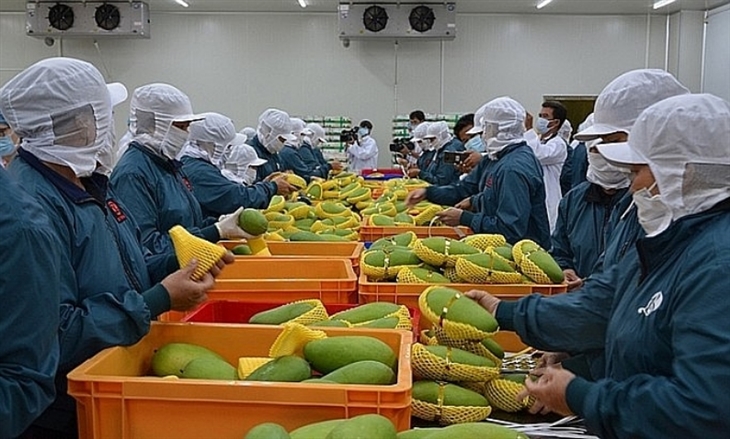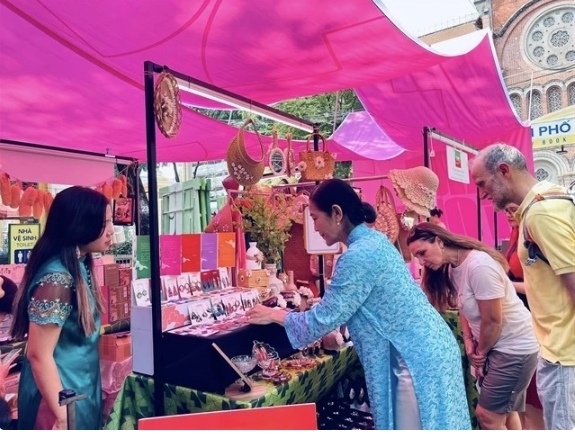Exporting fruits and vegetables to China: Choosing quality for long haul
Thursday, June 12,2025
AsemconnectVietnam - China is Vietnam's largest fruit and vegetable export market. Standardizing production to maintain export market is the top priority. China accounts for nearly 50% of Vietnam's fruit and vegetable export turnover
According to Vietnam Fruit and Vegetable Association, fruit and vegetable export turnover in May 2025 is estimated at only 496 million USD. In the first 5 months of 2025, the estimated fruit and vegetable export reached 2.1 billion USD, down 17.8% compared to the same period in 2024.
China is the largest export market for Vietnamese agricultural products in general and Vietnamese fruits and vegetables. In 2024, this country spent 4.6 billion USD to import Vietnamese fruits and vegetables. In the first quarter of 2025, Vietnam's fruit and vegetable exports to the Chinese market reached 521.2 million USD (accounting for 47.8% of total export turnover of the entire fruit and vegetable industry in Vietnam).
Notably, according to data from China Customs, in the first quarter of 2025, the country spent 29 million USD importing mangoes from 6 countries, an increase of 21 times compared to the same period last year. In context of China's mango imports from 5 other markets simultaneously decreasing, Vietnam became a bright spot when both the output and export value of this item increased sharply.
Specifically, Vietnam exported nearly 40,700 tonnes of mangoes to China, earning 28 million USD, an increase of 145 times in value. Hoa Loc and Cat Chu mangoes are very popular with Chinese consumers. Vietnamese mangoes currently account for 97% of the market share of mangoes imported into China, far surpassing competitors such as Thailand, Peru, Australia, Cambodia and the Philippines.
Standardizing production to maintain the market
Recently, Ministry of Agriculture and Environment signed a Protocol on exporting Vietnamese chili, passion fruit, bird's nest and rice bran to the Chinese market. Thus, up to now, Vietnam and China have signed 24 memorandums of understanding and protocols on the import and export of agricultural, forestry and fishery products.
"China is still the largest market for Vietnamese durian. If we do a good job in processing instead of just relying on exporting fresh fruit, a target of more than 3 billion USD can be achieved, even up to 5 billion USD", Mr. Nguyen Manh Hung - founder of Nafoods Group Joint Stock Company - shared and said that the enterprise will pioneer in deep processing of durian.
According to Mr. Vo Quan Huy - Director of Huy Long An Company Limited, global durian market in 2025 will be worth about 200 billion USD and could reach 400 billion USD by 2035, with an average growth rate of more than 7% per year. In context of high consumer demand, ensuring a stable year-round supply is an important advantage for Vietnam.
Talking to reporters of Cong Thuong Newspaper, Mr. Dang Phuc Nguyen - General Secretary of Vietnam Fruit and Vegetable Association - said that with 1.4 billion people, China is the market with the most attractive purchasing power in the world. Vietnam has a great geographical advantage when it owns more than 1,450 km of border with China. In addition, China has many large wholesale markets located close to the northern border, a few hundred kilometers from Vietnam's agricultural growing areas. Thanks to that, logistics costs are low, transportation times are faster and more competitive than other countries.
At the same time, Vietnam's fruit and vegetable exports to Chinese market have increased sharply thanks to Free Trade Agreements (FTAs) such as the ASEAN - China Agreement, Regional Comprehensive Economic Partnership Agreement (RCEP) and the Protocols signed between the two countries. Therefore, there is still a lot of room for fruit businesses and exporters to exploit this market.
However, fruit and vegetable exports are no longer a "cheap game" or an easy market. As technical barriers become increasingly strict, proactive adaptation from growing areas to processing, logistics and destination markets... is a "vital" condition for Vietnamese agricultural products to firmly step on the global playing field.
Particularly for Chinese market, information transparency and traceability are important factors. Regarding this, Mr. Do Duc Duy - Minister of Agriculture and Environment - said that the Ministry is currently finalizing a Circular on management of codes for growing areas and packaging facilities. This will be the basic document regulating the entire production, processing, and technical control process.
This Circular will stipulate the conditions for granting, maintaining, suspending, or revoking codes; the responsibilities of local agencies, supervisory units, and enterprises; standardizing production, processing, and preservation processes in accordance with the requirements of the Chinese market and countries with high standards.
In addition, the Ministry is also developing safe agricultural practices and processing techniques, guidelines for the use of agricultural materials that minimize the presence of heavy metals, requiring the non-use of banned chemicals, and supporting the application of electronic diaries and digital traceability systems.
The Ministry of Agriculture and Environment clearly states that if the trust of the import market is lost, it will be extremely difficult to restore it. When trust is lost, importing countries often set up many technical barriers, even prohibiting the import of Vietnamese products, and negotiating to reopen the market becomes even more difficult. Therefore, the Ministry of Agriculture and Environment also recommends that localities publicly and transparently disclose the entire list of codes for growing areas and packaging facilities on the electronic traceability system, update them regularly; clearly assign supervision responsibilities at the commune and district levels, avoiding laxity or evasion of responsibility. Along with that, direct the temporary suspension of areas that do not meet the requirements of the importing country; codes for growing areas and packaging facilities that violate food safety and plant quarantine, not to "chase after quantity and lose the image and reputation of the country"; instruct people and businesses to fully record production diaries, properly implement technical processes and proactively control quality.
Source: Vitic/ congthuong.vn
China is the largest export market for Vietnamese agricultural products in general and Vietnamese fruits and vegetables. In 2024, this country spent 4.6 billion USD to import Vietnamese fruits and vegetables. In the first quarter of 2025, Vietnam's fruit and vegetable exports to the Chinese market reached 521.2 million USD (accounting for 47.8% of total export turnover of the entire fruit and vegetable industry in Vietnam).
Notably, according to data from China Customs, in the first quarter of 2025, the country spent 29 million USD importing mangoes from 6 countries, an increase of 21 times compared to the same period last year. In context of China's mango imports from 5 other markets simultaneously decreasing, Vietnam became a bright spot when both the output and export value of this item increased sharply.
Specifically, Vietnam exported nearly 40,700 tonnes of mangoes to China, earning 28 million USD, an increase of 145 times in value. Hoa Loc and Cat Chu mangoes are very popular with Chinese consumers. Vietnamese mangoes currently account for 97% of the market share of mangoes imported into China, far surpassing competitors such as Thailand, Peru, Australia, Cambodia and the Philippines.
Standardizing production to maintain the market
Recently, Ministry of Agriculture and Environment signed a Protocol on exporting Vietnamese chili, passion fruit, bird's nest and rice bran to the Chinese market. Thus, up to now, Vietnam and China have signed 24 memorandums of understanding and protocols on the import and export of agricultural, forestry and fishery products.
"China is still the largest market for Vietnamese durian. If we do a good job in processing instead of just relying on exporting fresh fruit, a target of more than 3 billion USD can be achieved, even up to 5 billion USD", Mr. Nguyen Manh Hung - founder of Nafoods Group Joint Stock Company - shared and said that the enterprise will pioneer in deep processing of durian.
According to Mr. Vo Quan Huy - Director of Huy Long An Company Limited, global durian market in 2025 will be worth about 200 billion USD and could reach 400 billion USD by 2035, with an average growth rate of more than 7% per year. In context of high consumer demand, ensuring a stable year-round supply is an important advantage for Vietnam.
Talking to reporters of Cong Thuong Newspaper, Mr. Dang Phuc Nguyen - General Secretary of Vietnam Fruit and Vegetable Association - said that with 1.4 billion people, China is the market with the most attractive purchasing power in the world. Vietnam has a great geographical advantage when it owns more than 1,450 km of border with China. In addition, China has many large wholesale markets located close to the northern border, a few hundred kilometers from Vietnam's agricultural growing areas. Thanks to that, logistics costs are low, transportation times are faster and more competitive than other countries.
At the same time, Vietnam's fruit and vegetable exports to Chinese market have increased sharply thanks to Free Trade Agreements (FTAs) such as the ASEAN - China Agreement, Regional Comprehensive Economic Partnership Agreement (RCEP) and the Protocols signed between the two countries. Therefore, there is still a lot of room for fruit businesses and exporters to exploit this market.
However, fruit and vegetable exports are no longer a "cheap game" or an easy market. As technical barriers become increasingly strict, proactive adaptation from growing areas to processing, logistics and destination markets... is a "vital" condition for Vietnamese agricultural products to firmly step on the global playing field.
Particularly for Chinese market, information transparency and traceability are important factors. Regarding this, Mr. Do Duc Duy - Minister of Agriculture and Environment - said that the Ministry is currently finalizing a Circular on management of codes for growing areas and packaging facilities. This will be the basic document regulating the entire production, processing, and technical control process.
This Circular will stipulate the conditions for granting, maintaining, suspending, or revoking codes; the responsibilities of local agencies, supervisory units, and enterprises; standardizing production, processing, and preservation processes in accordance with the requirements of the Chinese market and countries with high standards.
In addition, the Ministry is also developing safe agricultural practices and processing techniques, guidelines for the use of agricultural materials that minimize the presence of heavy metals, requiring the non-use of banned chemicals, and supporting the application of electronic diaries and digital traceability systems.
The Ministry of Agriculture and Environment clearly states that if the trust of the import market is lost, it will be extremely difficult to restore it. When trust is lost, importing countries often set up many technical barriers, even prohibiting the import of Vietnamese products, and negotiating to reopen the market becomes even more difficult. Therefore, the Ministry of Agriculture and Environment also recommends that localities publicly and transparently disclose the entire list of codes for growing areas and packaging facilities on the electronic traceability system, update them regularly; clearly assign supervision responsibilities at the commune and district levels, avoiding laxity or evasion of responsibility. Along with that, direct the temporary suspension of areas that do not meet the requirements of the importing country; codes for growing areas and packaging facilities that violate food safety and plant quarantine, not to "chase after quantity and lose the image and reputation of the country"; instruct people and businesses to fully record production diaries, properly implement technical processes and proactively control quality.
Source: Vitic/ congthuong.vn
Vietnam's import-export and trade balance in first 5 months of 2025
Top 5 localities with the highest industrial production index
Rice exports in first 5 months of 2025
Vietnam’s industrial index in first 5 months of 2025
Agricultural, forestry and fishery exports and imports: situation and measures to facilitate
Challenges and measures to promote Vietnam's imports and exports
Nam Dinh industrial production increased by 29.16% in 5 months of 2025
3 highlights of Vietnam's manufacturing industry in May
Immediate customs clearance for agricultural, forestry and fishery exports prioritized
Ministry of Industry and Trade strengthens tobacco business management
Vietnam petroleum market – May 2025
Vietnam Fruit Market Update – May 30, 2025
Rice prices on May 30: Slight Decline in Domestic and Export Markets
DAILY: Domestic coffee prices fell on May 30, 2025

Plan of Hai Duong province for a period of 2021 - 2030, ...
Organize space reasonably and harmoniously, focusing on connecting Hai Duong in common development space, actively contributing to the ...Plan of Hau Giang province in a period of 2021 - 2030, ...
Sustainable forestry development program in a period of ...

Art programme honouring Ao dai opens at HCM City Book ...
An art programme to honour and promote traditional cultural values and the beauty and grace of Ao dai has opened in Ho Chi Minh City. It ...From Hanoi to Brussels – a cross-cultural musical journey
Talented youngsters to enjoy int'l football ...
Tien Linh, Thuy Trang win Vietnam Golden Ball 2024
HCM City’s ao dai festival to feature mass folk dance with ...



